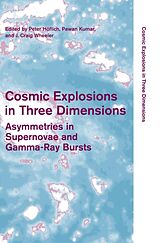Cosmic Explosions in Three Dimensions
Einband:
Fester Einband
EAN:
9780521842860
Untertitel:
Asymmetries in Supernovae and Gamma-Ray Bursts
Autor:
Peter Kumar, Pawan Wheeler, J. Craig Hoflich
Herausgeber:
Cambridge University Press
Anzahl Seiten:
392
Erscheinungsdatum:
28.06.2016
ISBN:
0521842867
Highlights routine supernova polarimetry and new insights into core collapse and thermonuclear explosions.
Autorentext
Peter Hoflich is a Research Scientist at the University of Texas in Austin, where he mainly works on problems of radiation transport, non-LTE atmospheres, polarization, hydrodynamics and radiation hydrodynamics. Pawan Kumar is Professor of Astronomy at the University of Texas at Austin where he is a key member of the innovative UTeach science education program. He is an expert on helioseismology. J. Craig Wheeler is the Samuel T. and Fern Yanagisawa Regents Professor of Astronomy at the University of Texas at Austin, and was Chair of the Astronomy Department from 1986 to 1990.
Klappentext
Recent observations have demonstrated that supernovae and gamma ray bursts are driven by strong jets of energy and other asymmetrical effects that reveal unknown physical properties. This volume highlights the burgeoning era of routine supernova polarimetry and the new insights into core collapse and thermonuclear explosions. Chapters by leading scientists summarize the status of a rapidly developing perspective on stellar explosions in a valuable resource for graduate students and research scientists.
Zusammenfassung
Supernovae and gamma-ray bursts are the strongest explosions in the Universe. Observations show that, rather than being symmetrical, they are driven by strong jets of energy and other asymmetrical effects. This volume marks the transition to a fresh paradigm in the study of stellar explosions.
Inhalt
Introduction: 3-D Explosions: a meditation on rotation (and magnetic fields) J. C. Wheeler; Part I. Supernovae: Observations Today: 1. Supernova explosions: lessons from spectropolarimetry L. Wang; 2. Spectropolarimetric observations of Supernovae A. Filippenko and D. C. Leonard; 3. Observed and physical properties of type II plateau supernovae M. Hamuy; 4. SN1997B and the different types of Type Ic Supernovae A. Clocchiatti, B. Leibundgut, J. Spyromilio, S. Benetti, E. Cappelaro, M. Turatto and M. Phillips; 5. Near-infrared spectroscopy of stripped-envelope Supernovae C. L. Gerardy, R. A. Fesen, G. H. Marion, P. Hoeflich and J. C. Wheeler; 6. Morphology of Supernovae remnants R. Fesen; 7. The evolution of Supernova remnants in the winds of massive stars V. Dwarkadas; 8. Types for the galactic Supernovae B. E. Schaefer; Part II. Theory of Thermonuclear Supernovae: 9. Semi-steady burning evolutionary sequences for CAL 83 and CAL 87: supersoft X-ray binaries are Supernovae Ia progenitors S. Starrfield, F. X. Timmes, W. R. Hix, E. M. Sion, W. M. Sparks and S. Dwyer; 10. Type Ia Supernovae progenitors: effects of the spin-up of the white dwarfs S.-C. Yoon and N. Langer; 11. Terrestrial combustion: feedback to the stars E. S. Oran; 12. Non-spherical delayed detonations E. Livne; 13. Numerical simulations of Type Ia Supernovae: deflagrations and detonations V. N. Gamezo, A. M. Khokhlov and E. S. Oran; 14. Type Ia Supernovae: spectroscopic surprises D. Branch; 15. Aspherity effects in Supernovae P. Hoeflich, C. Gerardy and R. Quimby; 16. Broad light curve SneIa: asphericity or something else? A. Howell and P. Nugent; 17. Synthetic spectrum methods for 3-D SN models R. Thomas; 18. A hole in Ia' spectroscopic and polarimetric signatures of SN Ia asymmetry due to a companion star D. Kasen; 19. Hunting for the signatures of 3-D explosions with 1-D synthetic spectra E. Lentz, E. Baron and P. H. Hauschildt; 20. On the variation of the peak luminosity of Type Ia J. W. Truran, E. X. Timmes and E. F. Brown; Part III. Theory of Core Collapse Supernovae: 21. Rotation of core collapse progenitors: single and binary stars N. Langer; 22. Large scale convection and the convective Supernova mechanism S. Colgate and M. E. Herant; 23. Topics in core-collapse Supernova A. Burrows, C. D. Ott and C. Meakin; 24. MHD Supernova jets: the missing link D. Meier and M. Nakamura; 25. Effects of super strong magnetic fields in core collapse Supernovae I. S. Akiyama; 26. Non radial instability of stalled accretion shocks advective-acoustic cycle T. Foglizzo and P. Galletti; 27. Asymmetry effects in Hypernovae K. Maeda, K. Nomoto, J. Deng and P.A. Mazzali; 28. Turbulent MHD jet collimation and thermal driving P. T. Williams; Part IV. Magnetars, N-Stars, Pulsars: 29. Supernova remnants and pulsar wind nebulae R. Chevalier; 30. X-Ray signatures of Supernovae D. Swartz; 31. Asymmetric Supernovae and Neutron Star Kicks D. Lai and D. Q. Lamb; 32. Triggers of magnetar outbursts R. Duncan; 33. Turbulent MHD Jet Collimation and Thermal Driving P. Williams; 34. The interplay between nuclear electron capture and fluid dynamics in core collapse Supernovae W. R. Hix, O. E. B. Messer and A. Mezzacappa; Part V. Gamma-Ray Bursts: 35. GRB 021004 and Gamma-ray burst distances B. E. Schaefer; 36. Gamma-ray bursts as a laboratory for the study of Type Ic Supernovae D. Q. Lamb, T. Q. Donaghy and C. Graziani; 37. The diversity of cosmic explosions: Gamma-ray bursts and Type Ib/c Supernovae E. Berger; 38. A GRB simulation using 3D relativistic hydrodynamics J. Cannizo, N. Gehrels and E. T. Vishniac; 39. The first direct link in the Supernova/GRB connection: GRB 030329 and SN 2003dh T. Matheson; Part VI. Summary: 40. Three-dimensional explosions C. Wheeler.

Leider konnten wir für diesen Artikel keine Preise ermitteln ...
billigbuch.ch sucht jetzt für Sie die besten Angebote ...
Die aktuellen Verkaufspreise von 6 Onlineshops werden in Realtime abgefragt.
Sie können das gewünschte Produkt anschliessend direkt beim Anbieter Ihrer Wahl bestellen.
Loading...
Die aktuellen Verkaufspreise von 6 Onlineshops werden in Realtime abgefragt.
Sie können das gewünschte Produkt anschliessend direkt beim Anbieter Ihrer Wahl bestellen.
| # | Onlineshop | Preis CHF | Versand CHF | Total CHF | ||
|---|---|---|---|---|---|---|
| 1 | Seller | 0.00 | 0.00 | 0.00 |
